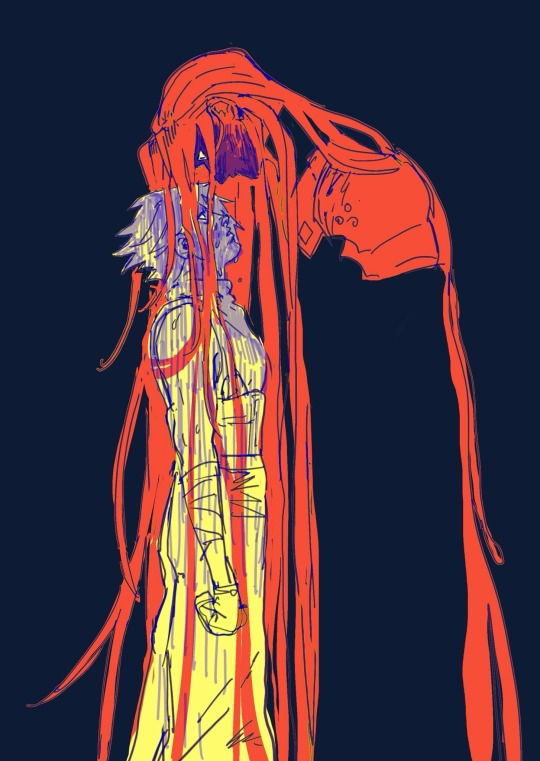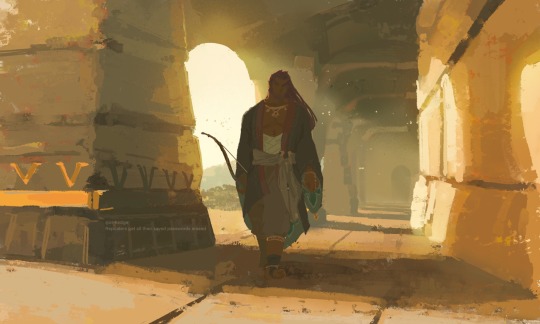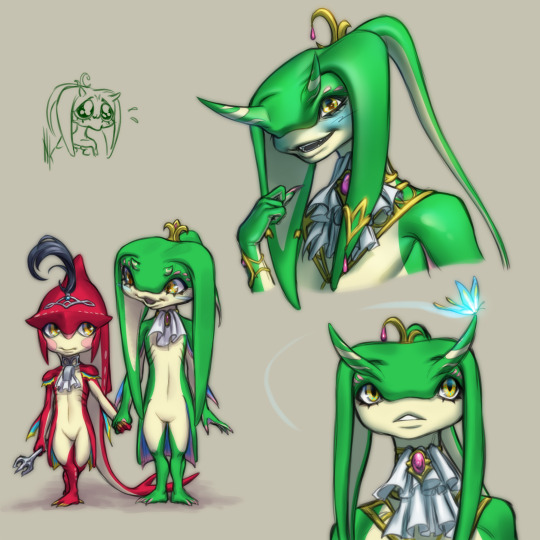they/themam goign insananything and everything. mostly zelda. definitely mostly zelda.
Don't wanna be here? Send us removal request.
Text










I needed the skywheel date with Sephiroth in Rebirth..
1K notes
·
View notes
Text

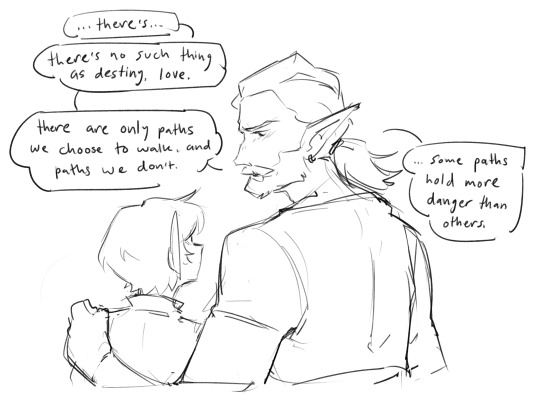
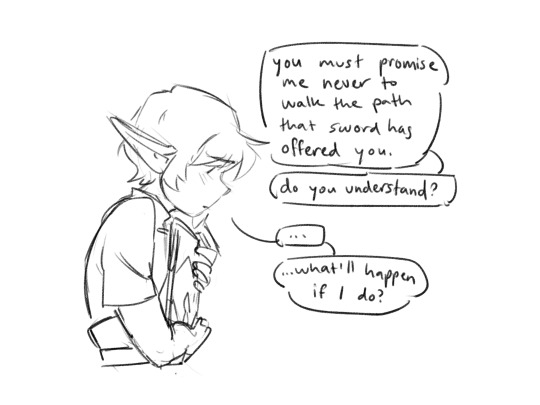



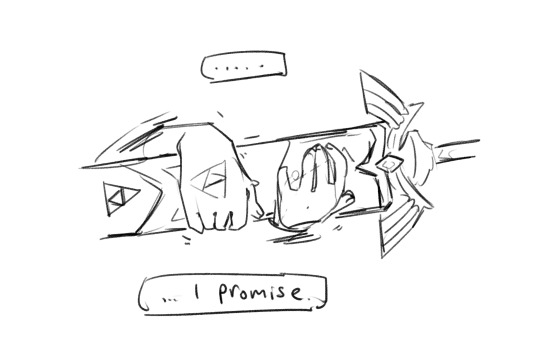
not exactly a full comic or anything but considering it's been 2 years since i've touched this au i think this warrants some fanfare. new coliseum au content everyone come get your content
(sequentially this would take place directly after the sword-claim scene in part 4. don't expect any more elaboration on this ever btw)
2K notes
·
View notes
Text
I feel like there's something to be said about how the Sheikah and the Gerudo are essentially two sides of the same coin.
This is how I see it: The Yiga Clan reflects the Gerudo from Ocarina of Time where both groups are ostracized and persecuted to a point where there is little room for compromise or coalition with the Royal Family. Hell, these people even live in the desert and are called thieves (which is just Hyrule's shorthand for "we've killed so many of them and left the rest to fend for themselves in a place that bears little to no resources needed for survival") just like the Gerudo.
And it's heartbreaking in a way, how Urbosa calls the Yiga members traitors instead of realizing she's looking at a mirror of what her people had once endured. Especially since the game heavily implies that her involvement as a Champion is largely characterized by her effort to try and redeem her tribe since the events of Ocarina of Time to the rest of Hyrule for something that was not even their fault.
Sure, there is no denying that Ganondorf was ultimately misguided in his conquest for power, but there's the part that goes unsaid where Demise ensured that his hatred would reincarnate, no? And well, hatred isn't mindless. It cannot exist without a trigger.
The Royal Family of Hyrule forced his hand, just like it forced the Sheikah's. And the sooner Urbosa could have realized that, then the sooner she would have understood why the Yiga were so hellbent on vengeance.
295 notes
·
View notes
Text
I will now yell about Fi and Ghirahim as symbols of their respective creators, please stand by:

So, the biggest slap addition the lore that Skyward Sword gave us was (Her Grace) Hylia and (the Bringer of) Demise. Entities who, regardless of confusing localisation choices, exist as two sides of the same coin and are locked into a mutual karmic cycle.
They reflect each other like a mirror, and also represent an antithesis of each other, seemingly existing as consequence to one other. They were presented as the penultimate deities of the physical and metaphysical realms of their world since the advent of its creation by the departed Golden Goddesses; twinned yet opposite, and each both inevitable and necessary.
Shadow; Light. Chaos; Order. Indulgence; Restraint. Upheaval; Stability. Primordial; Designed. Spite; Grace. Hidden; Seen.
Ghirahim; Fi.
It goes right down to the blades that Demise and Hylia would level at one another. The spirits of each are a representative of the principles and philosophy championed by their creators.
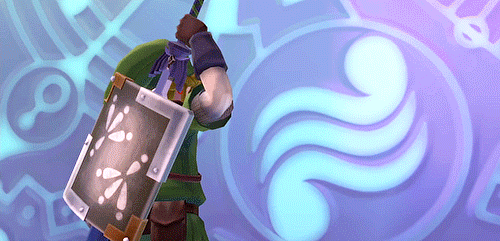
Now, the closer you get to the works and relics of the Gods/Gods Tribe in Zelda, the more you see divine constructs that blur the line of spiritual magic and advanced technology, and are ostensibly both. This was a direction that really bloomed in Skyward Sword, taking a running start on it that games hereafter have followed. The caveat is that only certain special people chosen by Gods or otherwise given permission to use this kind of Magitech can interact with it or produce things like it (either at all, or without punishment).
Even the Sheikah, who have closely served the intentions of the Gods/Spirits of Light (Hylia and her aligned) all throughout history, make the mistake of getting too comfortable in their inspiration and cross the line into imitations. Despite the successful utilisation of, and later recovery of, certain Sheikah Tech such as the Divine Beasts to positive effect, the tragedy of both the Sheikah's Divide and the Calamity's hijacking of Hyrulean defence systems is still played as a cautionary tale of hubris and knowing one's place in the natural order of things.
The Sheikah were effectively making unauthorised knockoffs of Divine Magitech and it bit them on the arse.
Can't have shit in Hyrule.
Pretty much every significantly advanced tribe in Zelda has a stated closeness to 'the Gods'. Either by being adjacent to or descended from deities and spirits collectively known as the Gods (specifically the Gods Tribe in JP), they are still distinctly subordinate to and separated from entities such as Hylia and the three Golden Goddesses.
Confirmed to be included in this special grouping are the Zonai and the Oocca, for instance. Speculatively, the Wind Tribe are an example of people who ascended (with permission or worthiness) from the surface-- they are an arguably Gerudo adjacent tribe who may even be precursors to the Zonai or related to the Twili.
The Picori, at the very least those in their native realm, also certainly count as part of this grouping. Though it could be argued whether those descent Minish living on the surface still do.
The Sheikah, it should be noted, have never gained entry to this Gods club. Despite their proximity in worship and service to Hylia, historically, they've also done some pretty shady things-- like the Shadow Temple and the general murder and espionage stuff -- that may have otherwise excluded them from ascending like the Wind Tribe did. They walk a grey line, and they have a duty in the eyes of the Powers That Be that apparently prefer they stay put.
Not Turtle-y enough for the Turtle Club.
Another example of this Icarus flying too close to the Sun type cautionary tale, and a far more egregious offender in the eyes of the Gods Tribe, are the 'Interlopers' who would eventually become the Twili. They were a tribe of people that, while squabbling with others, tried to take dominion of Hyrule (referred to itself as the Sacred Realm/Holy Land in TP) with powerful magic that more or less gave them a winning advantage. Specifically, the Crystal Stone of Shadow (the Fused Shadow) which greatly amplified their magical power.
Banished by the Spirits of the Light whole cloth into an underworld (lit. A Realm of the Dead) that we also know as the Twilight Realm, they have been shunned from the land they tried to conquer and transformed by shadow so much, they're now allergic to the light (without sufficient mystical power to bolster themselves).

Basically, the intended message is this: any earthly people who have advanced themselves without approval by the Gods Tribe-- especially by using Divine Constructs as inspiration or means-- have therefore disrupted the order of things, and stacked the deck too much in their own favour. Even if the intent was primarily a fixation on preserving Hylia's bloodline, and by extension her sacred land, it is still possible to elevate oneself above your contemporaries (especially the capacities of the Royal Family line in Hyrule) in such a way that you impose too much independent influence upon the the natural world.
No longer following 'the way of the Gods' (the Gods Tribe law) or respecting the order of things (ala Shintoist inspiration), you are labelled a disruption to harmony and peace, and therefore seen as corrupted and pollutive, and generally negative in your impact. You will then be chased off, at the very least, unless you renege-- for fear that you will bring in demonic influences or be used by them. This has canonically happened to both the Gerudo and the Sheikah, now.
But you know who Magic Constructs on par with the Gods Tribe, except it's more eldritch and organic-looking and primordial in form? It's the other club, the one that the disenfranchised Sheikah went and banged on the door of, hoping to be let in if they started wearing cool red and black outfits and changed their name and stopped worshipping Hylia.
Yeah. It's the Demon Tribe-- who are pretty much just the inverse reflection of the Gods Tribe and its set up. Their Magitech equivalents, and what they can do, only serve to further cement this.
Specifically, if you could suggest that the Gods Tribe's main objective is maintaining a status quo of shared prosperity that provides an ordered and peaceful existence through conformity and tradition, the Demon tribe is an ever churning well of opportunity where winner takes all. It is a hierarchy built on brutal meritocracy, honed by constant challenges and hard won continuation-- survival and status fought for and maintained by individualistic influence and innovation.
Many various little bastards exist in the Demon Tribe. Bosses in charge of sub-tribes of monsters are commonly seen, but they have their minor Deities ad Spirits, too. The head honchos are called Demon Kings (plural, because it doesn't describe a single position, but rather just very powerful Demons who have clout). Demise is both a Demon King, namely the most powerful one, and also the 'Chief' of the Demon Tribe; just as, in this case, Hylia could be considered the 'Chief' of the Gods Tribe. So, Demon God-King, really.
While Demise is incapacitated by Hylia's seal, his role as the Chief of the Demon Tribe is actually the position that Ghirahim fills in for as his (literal) right hand man-- the very extension of his arm, as his blade.
Both the Master Sword (Fi) and Ghirahim himself are, perhaps, some of the most advanced forms of this sort of Magitech we've actually ever seen.
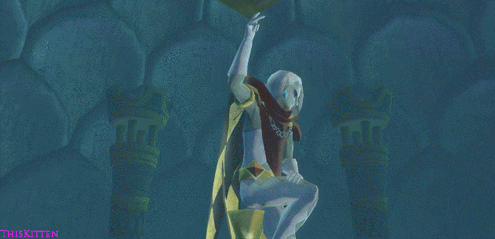
Ghirahim goes above and beyond in his role, even going so far as to cultivate his full persona as a Demon in his own right in order to maintain his authority as the effective Regent while the big boy is incapacitated. He disguises his true form and nature, and with a surprising level of autonomy and self-transformation for what he is, sets about attending his duties with great devotion.
He seems to have an incredibly intuitive and flexible mode of operation. His sentience is full of creativity, emotionality, and genuine potential that he has the capacity to explore and shape with great freedom, for the construct that he is.
He is flamboyant and attention grabbing, highly expressive. He entertains great personal indulgence, even going so far as to toy with Link in a manner that borders on vicious training for a while. Though in part due to his undeniable sadism, Ghirahim almost can't help himself but to continue to test and push against the potential as a swordsman that the Hero has, inadvertently cultivating its growth.
This depth of identity and adaption he's capable of was either an intentional part of his design, or specifically not prevented by it-- both of which stand to represent something of Demise and Demonkind. The lengths to which Ghirahim is allowed to wield himself when not in his creator's hand is remarkable and, though he is shown to be unable to override actual commands from his master, it stands in an interesting contrast to Fi.
Where Ghirahim is able to radically redefine his own presentation and function to best suit his Master's needs in a way that mimics the organic, Fi's evolution is far more linear and streamlined, never really deviating from systematic updates. Though the sword itself is subject to physical restorations, Fi's personal appearance is unchanged and reflective of her true shape, indicating that her tempering in the Sacred Flames is either a slow return to previous form or a pre-programmed and permanent upgrade set into motion by Hylia. It is also an evolution that is entirely dependant upon the actions of others, largely lacking the individual agency and flexibility that Ghirahim possesses.
Not to suggest that Fi is any less devoted to her purpose, however.
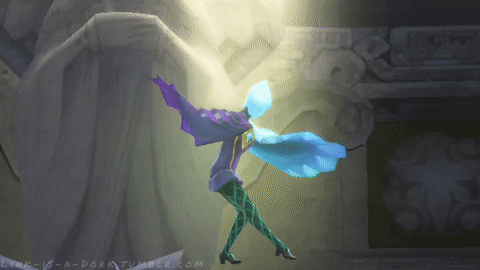
She is, quite unlike Ghirahim's aspect of individual advancement, wholly geared toward a model of mutual enhancement with a partner. She is built with a singular and clear objective in mind, perfectly designed to suit the needs of the one wielding her as a supplement to their ability, rather than an autonomous servant. She defers entirely to her Master's decisions at all times, though does make informed suggestions, and does not appear to be able to relocate the physical sword on her own. Many of her abilities are things that must be directly requested of her.
Even when she is given to performance, such as her singing or her ballet, these are seemingly dispassionate affairs that are precisely executed, preprogramed displays for Link's benefit. Absolutely nothing, not even particular inflections of emotionality, must risk the distortion of her relayed messages and guidance to Link-- these displays may also be something analogous to morale boosting rewards or a really weird form of reverence to the musically inclined Hylia. Either way, Fi is highly logical and presents herself foremost as an instrument and a tool. She does not indulge in a persona or otherwise engage in anything not directly tied to her assigned mission-- she does not get distracted or indulge personal whims as Ghirahim does. But critically, a large part of her design is geared towards an awareness of her surroundings. Fi has a visible consciousness for the living things around her at all times, contrasting to Ghirahim's seeming negligence of them and open disdain.
Fi's orderly efficiency and lack of cultivated personality to detract from her purpose make the fact of her construction obvious. Unlike Ghirahim, her true nature and her task is almost painfully undisguised. She exists in a simple sincerity, almost austere, seemingly unwilling or unable to seek function beyond her designation without being updated by another. However, her concentrated application seems to achieve concentrated results, strengthening both herself and her wielder in a near impenetrable mutual reinforcement.
It is perhaps of no coincidence that, despite Fi's seeming inflexibility and clinical pragmatism, she also expresses something of a fondness for Link at the end-- in many ways, mirroring her Divine creator. She does this very robotically, by correlating her collected data time spent together and their completed task with what she's observed of human happiness.
Skyward Sword seems to argue that Ghirahim's main flaw is spreading himself too thin, or trying to be so many other things, that he falls short as a sword in the end. It suggests that his sin, like others in the franchise, is getting too big for his boots scabbard and letting his pride become his downfall. His individualism gets presented with a great cost, as he has only enhanced himself in ways that seemingly do not apply when he returns to his primary function as a sword. The emotionality he has, such as the frustration and cockiness and bloodlust he indulges, are also shown to lower his successes-- reducing the sense of his efficiency and precision beside the ever level, measured Fi.
When he returns to Demise's hand, Ghirahim is already weakened and spent. Despite all he's done for his Master's revival, Demise is left to fight with a paling version of the blade that once fatally wounded Hylia-- not unlike a Master Sword in need of restoration to its full power.
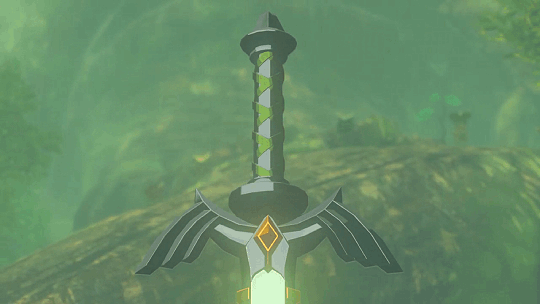
There's a legend regarding Gorō Nyūdō Masamune, widely regarded as the greatest swordsmith in Japanese history, and Sengo Muramasa, who is famously known for creating unique and terrifically sharp blades that are considered cursed.
It starts when Muramasa challenges Masamune to see who can make a finer sword. When the work is done, they go down to a river, and place the blades in the water with the cutting edge towards the current.
Muramasa's sword, which he named Ten Thousand Winter Nights, cuts everything that floats its way-- leaves, fish, even the wind that happened across it. It is so sharp that nothing escapes unscathed.
Masamune's sword, named Tender Hands, is placed in the river and cuts the leaves that go by so seamlessly, they reform on the other side. Fish swim up to it and seem to be repelled by its aura, avoiding death. The wind kisses the blade gently with a pleasant whistle.
Muramasa isn't impressed by this. He thinks the blade is useless, barely cutting anything at all, and starts to remark on the lack of skill. Masamune smiles at the criticism, but merely compliments that Muramasa's sword is indeed quite sharp.
A monk who had watched all this from nearby approaches at that point, bows, and interjects with his own observations.
Though he too observes that Muramasa's sword is technically very finely made, he notes that it's a bloodthirsty, wicked blade. It cuts anything in its path indiscriminately, he says, and would just as soon cut a butterfly in half as remove somebody's head.
Masamune's sword, however, was the clear winner in the monk's opinion-- a gentle blade that did not needlessly cut that which was innocent or undeserving, tempered by grace. It is a benevolent sword, and so far finer made.
In popular culture, Muramasa's blades have held onto their violent reputation. There's a superstition that they can compel their wielder to murder. It has even been said that, once drawn, they can't be sheathed again until their thirst for blood is sated-- even if it has to drink from its own wielder.
They also had a weirdly consistent habit of maiming or killing members of the Tokugawa Shogunate, and so became an anti-Tokugawa symbol synonymous with the rebellion. So that's fun.
But Masamune was considered to be a very calm man, who was controlled and reserved and quite spiritual. Muramasa, though, was depicted as an aggressive man, who was a bit wild and kinda unpredictable. As far as the folk stories go, Muramasa is depicted as having been quite envious of Masamune. Unlike Masamune, who approached his craft as the art of achieving clean death, they say Muramasa needed to transfer his unhinged energy into his blades to keep from being overwhelmed by it himself.
Because their natures bled into the swords they created, it was believed that Masamune and Muramasa imbued them with purifying and demonic power, respectively.
Just as with Demise and Hylia and the swords that they created-- as inspired by such a legend-- the spirits inside of them represent their natures, as well.
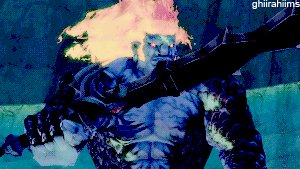
119 notes
·
View notes
Text
Honestly can't get over the three springs quests, in that link and hylia held multiple, actual conversations, where hylia asked him to check on the mother statue, he explained the situation, and she thanked him and asked for a dragon piece again, that the offering might boost her power and she could send it through to the big statue. That, and the bargainer statue possessing her plateau statue, implies a really weird relationship between hylia and her idols.
Like anyone listening to link about it would be like,
Link: and then I found my first sages will! I had no idea what it was for at the time, hylia had mentioned it but she never explained -
Person: hold up hold up hold up. Lady hylia? The mother goddess?? Protector of hyrule???
Link, who's only ever been able to remember getting instant responses and knows zelda not hearing anything was a big deal the whole kingdom knew about:...... Yeah?
Person: lady hylia?
Link: *mildly discomfited* yes?? I mean she's busy but I keep her updated, you know? I trade the sages wills with her to enhance the vows, but like I said, I didn't know that at the time, and I'm finding these things just in chests, I'm really not sure they're corporeal enough for -
Person: can we rewind hylia talks to you??
Link, cottoning on a bit: is that not... Normal?
Person, shrieking: NO THE HYLIA STATUE COMING TO LIFE AND TALKING TO YOU ISN'T NORMAL NO ONE DOES THAT????
231 notes
·
View notes
Text
Tears of the Kingdom confirms that 100 years old is about middle age for Zora which is perfectly in line with what information we had been given in BotW regarding Zora age and growth.
Rivan was the only Zora to give a concrete age being "over 130" and claimed that he and Link swam together as childhood friends when Link stayed at the Domain along with the rest of the "Big Bad Bazz Brigade".
"Well, it has been 100 years since then. And now I'm over 130 years old..." / "We used to swim together when I was but a child... Remember?" –Rivan

Furthermore, Rivan has a daughter named Dunma who was very adamant about being not yet 100 years old. She claims that she doesn't speak like those over 100, and now in TotK, another Zora mentions that Zora over middle age of 100 speak differently, more "eloquently".
"We Zora tend to speak more eloquently after reaching middle age." / "I hope that when I reach 100 years, I will also speak as beautifully as our elders. Unless that is too...OLD-fashioned, heh." –Fronk (TotK)
[edit: I got the quote off my Switch after work]
It's hard for me to tell in English, so I can't tell whether Dunma has changed her manner of speech which could suggest she is now 100 years old—she didn't seem that far from the milestone in BotW.
"*sigh* Let's just say I'm less than 100 years old. Can't you tell?" –Dunma
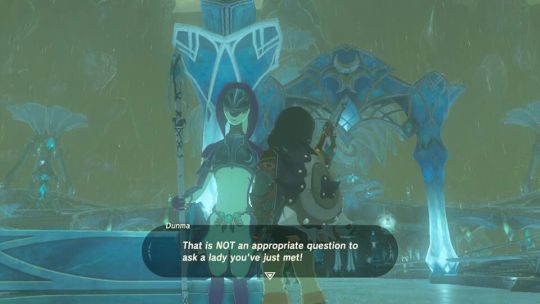
So we can get a good picture of Zora age to maturity with Rivan: he was over 130 in BotW, his daughter was under 100 meaning that he conceived her in his 30s to 40s which suggests that full Zora adulthood is about that age like adult humans hitting about 20 years old. For simplicity, I assume Hylian 20 is about Zora 40.
We can use Rivan to determine how old he was when he called himself a child using Link's age. I assumed that Link was younger than Zelda at first because he is so short, but it turns out he is older since Paya's age was actually influenced by Link so that there be a character around his age:
"Initially, Paya was to be a very young girl, but due to a lack of girls around Link's age in the world, she was changed to be a young woman between 18 and 20 years old." –Creating a Champion
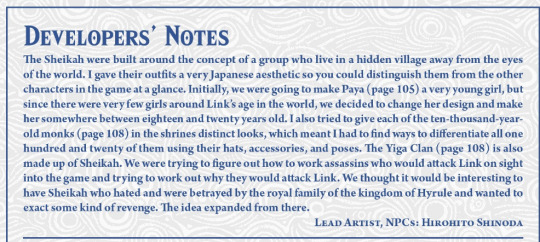
So I will assume Link is about 19 for simplicity.
If Link was 19 during the Calamity and was 4 when he first arrived at the Domain, then 15 years ago, Rivan who was (approximately) 35 during the Calamity would have been 20 years old. Considering that he was approaching 40 when he had Dunma, 20 years old for Zora may align with Hylians at 10 years old.
Since Rivan belonged to a group of friends along with Link, they were probably around a similar age. That includes Gaddison and Bazz in the "Big Bad Bazz Brigade"
"I must ask something of you, traveler. If you know it, speak it now. What is the Big Bad Bazz Brigade password? Fluffy white clouds! Clear blue..." [Zora] "Yes! There is no mistaking it! You are, indeed, the real Master Link!" / "[It's true.] I knew it! The only people who know that password are members of the Big Bad Bazz Brigade!" –Bazz
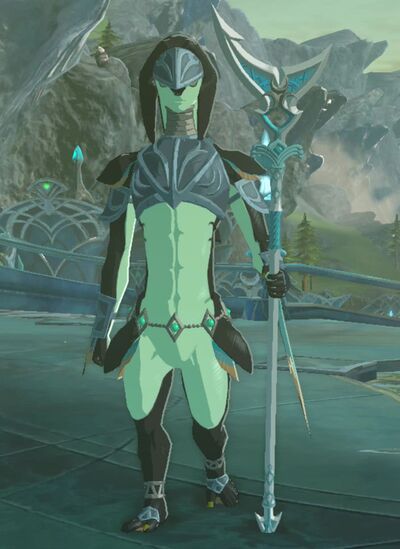
I will also include that Mipha died very young for a Zora since her spear is meant to accentuate her youth being taller than she is. Her short hight is a large part of it, but did you know that initially the adult Zora were meant to lose their tailfin? In the Creating a Champion book, the standard adult Zora design doesn't have a tailfin and their is a comment on the child Zora concept art states that all child Zora have the tailfin "like Mipha". This tailfin detail was not kept since all the Zora have tailfins in the game probably because their bare butts look pretty funny, haha.
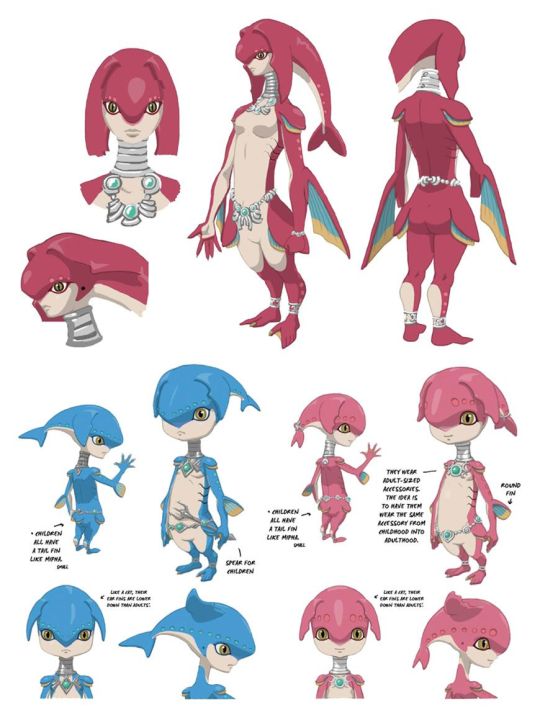
Since Rivan had a child in his 30s-40s quite soon after Calamity while Mipha was still so short, it seems that she was younger than Rivan.
It's hard to put a number on Mipha's age since we don't know when Zora hit that "growth spurt", but it is safe to say that she is in the middle of that growth. She did say that Link always seemed to grow a lot faster than she did, so this growth that she is going through isn't very fast compared to Hylians.
...
I would like to mention the elder Zora especially Dorephan who was incorrectly depicted in Age of Calamity. Age of Calamity simply reuses his model from BotW, but it is wildly inaccurate to how he is described 100 years ago in BotW.
The elder Zora seen in BotW were in their prime during the Calamity 100 years ago. Their generation was the one defending the Domain at the time, and Dorephan was described fighting a Guardian some time after the Calamity which resulted in his forehead scar seen in BotW. This event is stated to have happened 100 years after he became king and since Sidon appears to be taking on that title in TotK (I haven't finished the Domain, so this was gleamed from his appearance in the last trailer), then it may be safe to assume that Dorephan was about a similar age to Sidon when he became king being over 100 years old (middle aged).
"Around 100 years after King Dorephan ascended to the throne, a stray Guardian crossed Upland Zorana into our domain." / "You can still see the scar he earned that day on his forehead—a token of his triumph." –History of the Zora, Addendum 1

Rivan is yet again a good example of Zora age and maturity since his father Trello is in BotW and is wrinkled and old like the other elders while he and his daughter look quite similar in age.
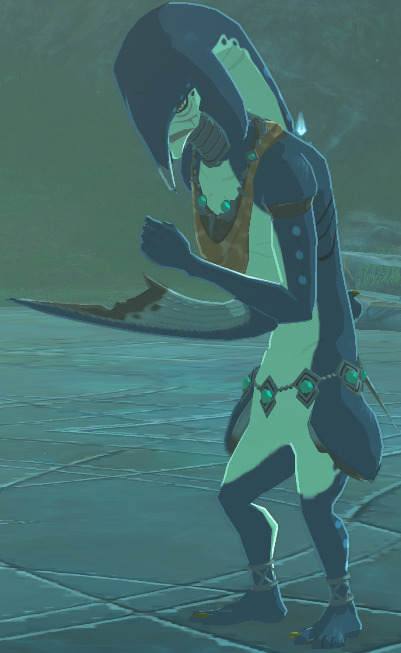
This shows that Dorephan who is part of the same generation as Trello would not be so old 100 years ago like he was depicted in AoC—with that forehead scar no less. (I liked AoC but this detail irritates me)
Considering the info available to us in BotW and TotK, Dorephan is likely over 200 and is in his elder years. It is safe to assume that Zora pass away before reaching 300.
So there you have it, an analysis on Zora age and maturity. They are still considered children in their 20s while they reach maturity around 40, they are middle aged at 100 and die of age before 300.
94 notes
·
View notes
Text
Okay so with the existence of Yona confirming that there are other Zora Domains with their own Royal families, there is no way in hell the one in Lanayru is just called, "Zora's Domain."
#can’t reply to the post but i like to think it’s called the Hyrulean Domain!!#i hc that there are some indoednant domains and nomadic tribes#and some domains associate themselves with pre-existing kingdoms and adopt the name of that kingdom#so like the domain in hyrule being the hyrulean domain etc etc#god i wish nintendo had done more with the zora worldbuiling#a girl can dream
47 notes
·
View notes
Text
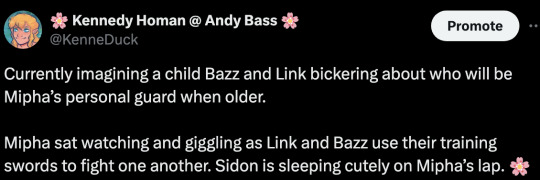




I may have been thinking about Link and Mipha today haha. ;;
340 notes
·
View notes
Text
A Record of the Calamity
This collection of meta essays explores the worldbuilding and cultural background of Hyrule and its inhabitants during the timeline of Breath of the Wild and Tears of the Kingdom.
Ninja Lore in Breath of the Wild On the historical precedents of the Sheikah, the origins of the names "Yiga" and "Kohga," and how the culture of historical ninja is referenced in the story and setting of Breath of the Wild.
Governance in Hyrule On the nature and questionable necessity of the Hyrulean monarchy in comparison with other systems of governance in Hyrule.
Zelda and the Calamity On how Zelda's repressed emotions may have surfaced in a tragic explosion of chaotic power.
Ganondorf as an Agent of Change On Ganondorf’s role as the villain of a heroic fantasy, the existential challenge he poses to Hyrule, and the necessity of disruption to an otherwise closed system.
Ganondorf’s Design in Tears of the Kingdom On the Japanese cultural references incorporated into Ganondorf’s visual design.
The Two Kings in Tears of the Kingdom On the fantasies of Japanese cultural identity represented by Rauru and Ganondorf, and why the power structures associated with the two kings are disavowed by Zelda.
349 notes
·
View notes
Text
YOU FOOLS! YOU BUFFOONS! THE ZONAI ARE NOT GOAT PEOPLE. RAURU IS NOT A HOT GOAT MAN. HE’S A HOT LLAMA MAN. THIS IS THE LEGEND OF ZELDA: GANON’S NEW GROOVE. WRONG LEVER, LINK. A LLAMA’S ARM?! RAURU’S SUPPOSED TO BE DEAD!!
LOOK AT THE BIG EARS. THE LONG TORSO. THE LONG NECK. THE HUGE MANE OF HAIR. THE PERUVIAN PONCHO. WE’RE IN THE ANDES MOUNTAINS. RAURU AND MINERU ARE LLAMAS 📣📣📣📣
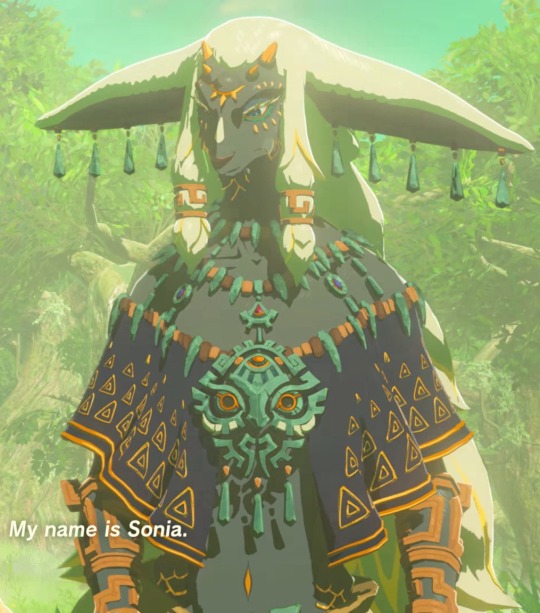

6K notes
·
View notes
Text
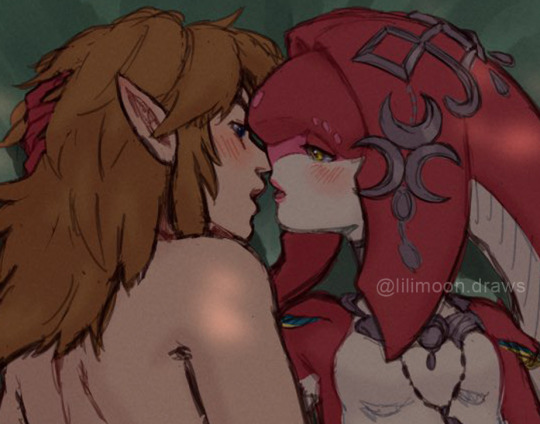
this is totally innocent! definitely nothing going on outside the crop, nope nope! 😇
243 notes
·
View notes
Text
I also cannot shake the idea that, as it's implied, Link was dragged, AWAKE, BY HIS GOOD ARM, from the bottom of Hyrule Castle, through the sky, by glowing disembodied arm
... before being stripped of his clothes and amputated (by who, a Construct?) , and left unconscious on the floor of a cave for an undetermined amount of time
And he's surprisingly unfazed by this, because weirder shit has happened
52 notes
·
View notes
